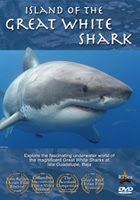 A possible migration corridor has been identified for great white sharks on the east coast of the U.S. A satellite tagging study was initiated in the fall by the Massachusetts Division of Marine Fisheries and some of the early results are intriguing. It is possible that the great white sharks that appear off the New England coast during the summer months - suspected of feeding on seal populations there - travel south during the winter months based on the results of a tagged shark who has appeared as far south as Jacksonville, Florida.
A possible migration corridor has been identified for great white sharks on the east coast of the U.S. A satellite tagging study was initiated in the fall by the Massachusetts Division of Marine Fisheries and some of the early results are intriguing. It is possible that the great white sharks that appear off the New England coast during the summer months - suspected of feeding on seal populations there - travel south during the winter months based on the results of a tagged shark who has appeared as far south as Jacksonville, Florida. Satellite tagging has been used on great whites and other shark species to record location, speed, depth, and ambient temperature. Typically, a well-placed tag will record data for 30 to as long as 90 days then release itself, float to the surface, and download its data to satellites overhead. Researchers must wait patiently then sift through a mountain of data when it is downloaded all at once. Satellite tags can provide more long-range data than regional telemetry tags (like those documented in my film, Island of the Great White Shark) but are also subject to being dislodged prematurely. A newer technique, SPOT tagging, bolts the tag to the shark to insure a significantly longer monitoring period, but requires that the shark be caught and brought on board; a technique that has raised considerable controversy because of the physical impact imposed on the shark during the procedure.
Satellite tagging has been used on great whites and other shark species to record location, speed, depth, and ambient temperature. Typically, a well-placed tag will record data for 30 to as long as 90 days then release itself, float to the surface, and download its data to satellites overhead. Researchers must wait patiently then sift through a mountain of data when it is downloaded all at once. Satellite tags can provide more long-range data than regional telemetry tags (like those documented in my film, Island of the Great White Shark) but are also subject to being dislodged prematurely. A newer technique, SPOT tagging, bolts the tag to the shark to insure a significantly longer monitoring period, but requires that the shark be caught and brought on board; a technique that has raised considerable controversy because of the physical impact imposed on the shark during the procedure.In the summer months, several species of shark inhabit the New England coastline, from basking sharks to thresher and blue sharks to the great white white (although not in significant numbers). This new tagging study is the first indication that, like their distant cousins throughout the world who exhibit distinct migratory patterns, white sharks could very well be moving up and down the east coast based on seasonal temperature changes and any changes in prey populations that those seasons impose.
Great whites have already been shown to migrate from the west coast Farallon Islands to the mid-Pacific; same for the white sharks at Isla Guadalupe. White sharks have been monitored moving from South Africa all the way to Australia and back. While there can always be the occasional exception, there is continuing evidence that these sharks and other pelagic species develop critical migratory patterns. Our concern would be, what would happen to these sharks if their migrations were intercepted by commercial fishing fleets? Or what would happen to the overall health of their populations with changes in ocean temperature due to global warming? How ingrained are these patterns and what would happen if external factors were altered - could the sharks successfully adjust?







1 comment:
Even the animals underwater are having a hard time living and it is kind of alarming. Need to makes something so that they will be stable.
Post a Comment